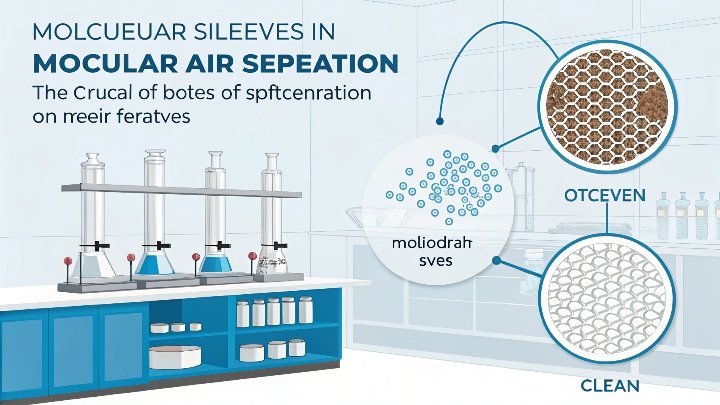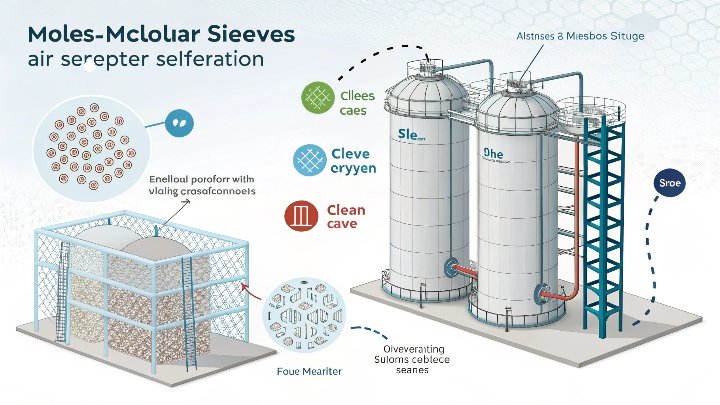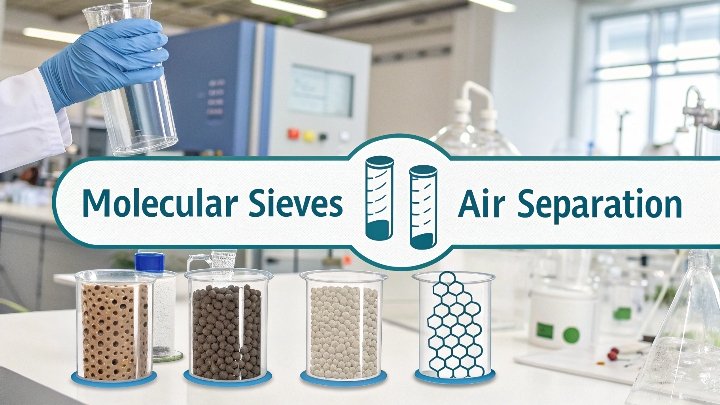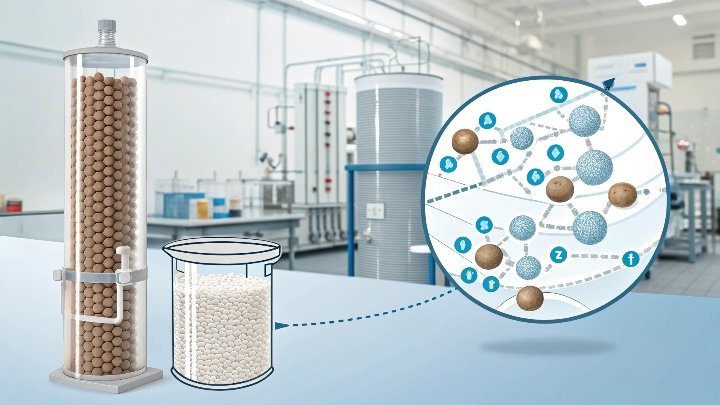Are air separation units draining our resources and making us frustrated? I once felt powerless against rising costs. But there is a smarter way to handle these challenges.
Molecular sieves help cut downtime and energy consumption in air separation units. They use selective adsorption to capture undesired molecules, making oxygen and nitrogen separation more efficient. This lowers costs and boosts production.
I remember feeling anxious about endless maintenance tasks and climbing power bills. I searched for ways to simplify operations and improve efficiency. Then I learned that molecular sieves offered a reliable fix. In the following sections, I will explain the major issues in air separation units and show how molecular sieves answer these challenges.
Major Challenges in Air Separation Units?
Battling costs and dealing with slow performance in air separation units made me question everything. I was ready to give up until I dug deeper into the main obstacles.
Common problems include high energy consumption, frequent shutdowns, and complicated maintenance. Many of us face these roadblocks without easy solutions. But we can tackle them by identifying root causes and adopting better practices. By addressing inefficiencies, we save resources and ensure stable operation in air separation units.
Major Challenges
I used to think air separation units were flawless because they seemed high-tech and advanced. But the reality revealed several roadblocks that demanded my attention. I saw high energy costs, reliability issues, and endless upkeep tasks. I also saw that different operating conditions required frequent adjustments, which often led to downtime. I realized that ignoring these challenges would lead to bigger problems later.
Energy Consumption
Energy usage stays at the top of the list. Air separation units need significant power to compress air and distill its components. Equipment that runs for long hours also uses more power than we might expect. In my experience, systems with older technology struggle with poor insulation and inefficient compressors. These flaws raise utility bills and put stress on daily operations.
Reliability and Maintenance
I recall times when a single valve failure caused unplanned shutdowns. These events caused me frustration because they led to production losses. Maintenance also poses serious costs. We need skilled workers and replacement parts to keep the units functioning. Regular calibration of sensors, control systems, and safety features becomes an endless chore.
Process Complexity
Another key challenge is the complex nature of air separation. We deal with intricate steps, such as cooling, distillation, and separation. Each step requires a controlled environment. If a part of the system drifts from its proper range, the entire process risks losing efficiency. This complexity pushes us to monitor system data and adjust parameters around the clock.
Below is a simple overview of challenges and potential fixes:
| Challenge | Impact | Possible Approach |
|---|---|---|
| High Energy Consumption | Increased operational costs | Better insulation, upgraded compressors |
| Frequent Downtime | Production losses | Routine maintenance and health checks |
| Complex Process Control | Lower separation efficiency | Improved sensors, automated controls |
| High Maintenance Demand | Increased labor and spare parts | Preventive schedules, staff training |
After examining these problems, I knew I had to look for a method that would ease the strain on the process. I wanted something that would reduce high energy bills and help control process parameters. At first, I was unsure if there was a single solution. Then I discovered molecular sieves and began to see how they could resolve many of these challenges.
Working Principles and Advantages of Molecular Sieves?
I felt overwhelmed by complicated separation methods. I worried that a new technology might be too complex to manage. But molecular sieves surprised me with their straightforward and effective process.
Molecular sieves operate through selective adsorption. They filter gases by size and polarity, which allows precise separation. This saves energy, lowers downtime, and makes air separation units more efficient.
Working Principles and Advantages
When I first heard about molecular sieves, I thought they were just special powders. I later learned they are crystalline structures with precise pore sizes. These pores capture molecules of a specific size while letting others pass. This selective process makes them useful for separating oxygen and nitrogen in air separation units.
Structure and Adsorption
Molecular sieves rely on a uniform network of tiny pores. These pores act like filters that hold onto certain molecules under specific conditions. For instance, in an air separation unit, nitrogen might get trapped while oxygen flows onward. The process is driven by differences in molecular size and interactions with the pore walls. This approach helps reduce the load on cryogenic or other distillation methods.
Advantages for Air Separation
Molecular sieves stand out for several reasons. First, they can handle large volumes of gas. This is vital for air separation units that run continuously. Second, molecular sieves allow for repeated cycles of adsorption and desorption. The adsorbent can be regenerated by heating or reducing pressure. This means we can reuse it multiple times. Third, the installation is simpler than some might expect. The system uses pressure swing adsorption (PSA) or temperature swing adsorption (TSA) methods. I found that these processes are easier to control compared to older technologies.
Another big advantage is energy savings. Selective adsorption means we do not need to rely solely on energy-intensive distillation steps. By integrating molecular sieves, we can streamline the process. That was a game-changer in my operation. Instead of running compressors at high power, I could optimize the system around PSA cycles. This led to fewer power spikes and more consistent performance.
Here is a quick overview of the advantages and outcomes:
| Advantage | Outcome |
|---|---|
| Selective Adsorption | High purity separation of gases |
| Reusable Adsorbent | Long product life and lower material costs |
| Reduced Process Complexity | Easier control with fewer system bottlenecks |
| Lower Energy Requirements | Reduced operational costs and footprints |
I also realized molecular sieves operate quietly in the background. They do not draw as much attention as big machinery or large distillation columns. Yet their impact on overall efficiency is huge. By integrating them, I saw fewer disruptions, lower energy use, and a smoother path to producing nitrogen or oxygen at desired purities. This shift helped me move away from the never-ending stress of monitoring so many variables. It also opened my eyes to simpler ways to handle gas separation needs.
Applications of Molecular Sieves in Addressing Air Separation Challenges?
I used to think the benefits of molecular sieves were limited. I then saw how flexible they can be for solving real-world air separation challenges.
Molecular sieves help with targeted gas adsorption. They speed up processes and cut energy use. They also reduce contamination and support sustainability in modern air separation systems.
Applications
I remember the day I installed molecular sieves in a small pilot system. We tried them to see if they could handle variable flows and changing feed compositions. The results were better than expected. Not only did we achieve higher purity levels, but the ongoing operating costs went down. That experience convinced me that molecular sieves are not just a passing trend.
Enhanced Oxygen Production
One key application is boosting oxygen production. Many facilities depend on oxygen for combustion processes or medical-grade supplies. Molecular sieves deliver consistent purities by trapping nitrogen and other unwanted gases. This reduces the load on cryogenic distillation or other complex methods. As a result, we get fewer shutdowns and a steady output of high-purity oxygen.
Lower Carbon Footprint
I am also excited about the environmental benefits. By relying on a selective adsorption process, we can trim the overall energy use. Lower energy needs translate into fewer carbon emissions. For me, this is a major advantage. Companies want to keep their operations efficient, but they also want to reduce their environmental impact.
High Nitrogen Purity
Another area where molecular sieves excel is in generating high-purity nitrogen. This is important for inerting or blanketing in various industries. Molecular sieves pick up residual oxygen and other impurities, which helps achieve the purity needed for sensitive processes. This approach helps reduce the chance of unwanted reactions or contamination.
Protecting Downstream Equipment
Molecular sieves also prevent moisture, oil vapors, or other pollutants from entering downstream systems. This keeps compressors, turbines, and other components in better shape. Less contamination means reduced equipment wear and fewer unplanned stoppages. I have seen how a clean process line can save large sums of money over time.
Here is an overview of some practical uses in air separation:
| Application | Role of Molecular Sieves | Benefit |
|---|---|---|
| Oxygen Production | Traps nitrogen and impurities | Stable high-purity O₂ supply |
| Nitrogen Generation | Removes oxygen to meet purity targets | Safe inerting and blanketing |
| Moisture Removal | Adsorbs water vapor | Protects downstream equipment |
| Energy Optimization | Decreases reliance on heavy distillation steps | Reduced overall power consumption |
I discovered that molecular sieves offer clear benefits for many different scenarios. They help me tailor the air separation process to the exact specifications needed. They also give me the freedom to run smaller or decentralized systems. This flexibility is a real advantage in settings where large cryogenic systems might not be practical.
Molecular sieves continue to evolve, and new types keep appearing. Some have improved adsorption capacity or better resistance to fouling. Others handle a broader range of contaminants. This progress shows that molecular sieves will likely remain key players in air separation technology. I have watched them transform from a niche solution to a standard approach for cutting downtime, lowering costs, and delivering cleaner air components.
Conclusion
Molecular sieves bring efficiency, reliability, and lower costs to air separation units. They give us a simpler path toward faster, smarter, and greener gas separation.






